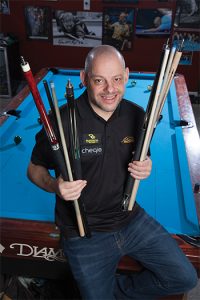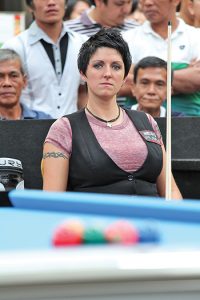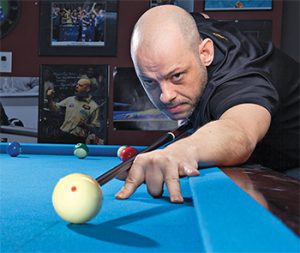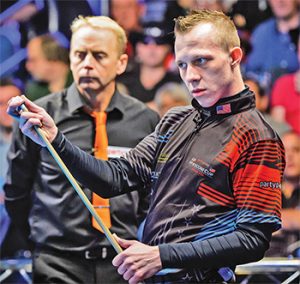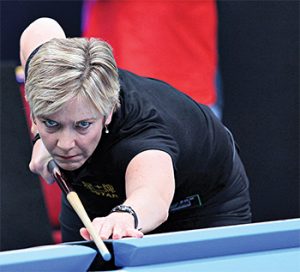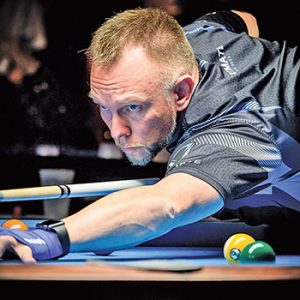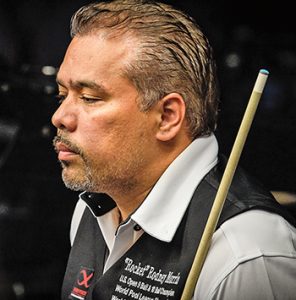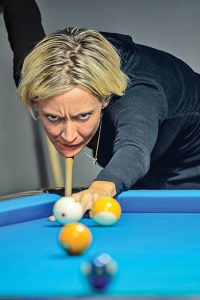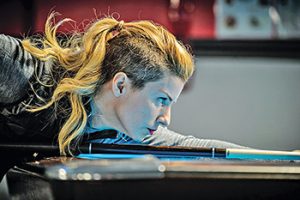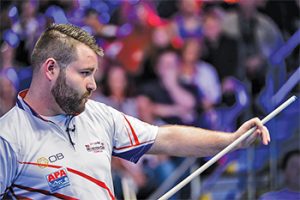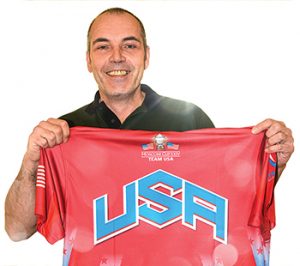A Cup Like No Other
The only thing certain about the 2020 Mosconi Cup is that nothing is certain. By Mike Panozzo
No matter how things shake out, 2020 promises to be a Mosconi Cup like no others.
Madness, partisanship and flag-waving figure to be replaced by bubbles, emoji cheers, elbow bumps and nose swabs, as the annual Europe vs USA slugfest reshapes itself in the wake of COVID-19’s seemingly endless assault on “normal.”
Just four weeks from the proposed start of the four-day team 9-ball event, only the lineups are set in stone, and even that could change at a moment’s notice.
Still to be determined are minor details, like, oh, the venue, live audience participation and which squad will be awarded a coveted second practice table.
The stubbornness of the global pandemic couldn’t have come at a worse time for pool in general and the Mosconi Cup in particular. Riding an unprecedented wave of popularity and success, the 26-year-old Matchroom Sport-promoted event was on pace to welcome 3,000 fans to each of the four sessions in 2020 and figured to continue its growth in television viewership.
Instead, Matchroom Multi Sport COO Emily Frazer and her crew are holed up in a virtual war room, planning for anything and everything that could alter the course of the event between now and its Dec. 1 start.
With sponsorship dollars trimmed and possibly no ticket revenue, Frazer recently acknowledged that the first order of business is finding a venue that could handle both a bubbled event and some live audience. The 2020 event is scheduled for London’s cavernous old Alexandre Palace, but the likelihood of it actually being staged there seems remote.
“Plan A is to move the venue,” Frazer said recently. “We have to be prepared for both behind-closed-doors and spectators. Massive tiered seating places like Ally Pally won’t work. We have to be really creative with the arena.
“Plan B is to create a bubble but find creative ways to get crowd engagement.
“And Plan C is to run away!”
If Frazer and her crew have proven anything in recent years, however, it’s that challenges are embraced more than feared.
“People have come to expect the best from us,” Frazer said. “So, we won’t deliver anything less than the best, regardless of the challenge.”
What appears to be the most manageable part of the equation to date is player logistics. Matchroom has been able to have players and coaches from both teams issued exemptions from the mandatory 14-day quarantine to enter the United Kingdom under an elite sportsmen rule unveiled by the British government earlier this year. According to rules, the players will have to be tested prior to leaving their country of origin and again after arriving in the U.K. Once cleared, all athletes will be limited in their exposure to non-athletes, living and performing in veritable bubbles.
According to Team USA Captain Jeremy Jones, his squad is scheduled to fly to London on Nov. 22, 10 days prior to the Cup.
“Once we get there, we’ll be okay,” he said. “Our travel will be limited.”
Of course, the possibility exists that a player and/or captain could test positive prior to the event.
“We have contingency plans in place, which the captains are comfortable with,” said Frazer.
According to Matchroom, once the event begins, players will not be required to wear masks during play, even during team and doubles matches.
In addition to protecting the players, Frazer said Matchroom staff will be quarantined and operate in a bubble as well. In addition to creating logistical hurdles, the precautionary measures also add costs to the already pricey event.
“We have to test early because we have to be able to replace people that test positive,” Frazer pointed out. “And then we have to quarantine everyone. During the snooker event in June, we had to cut the staff in half. You need to know who the key people are.”
Frazer said that Matchroom’s handling of professional snooker in June, where a small live crowd was allowed on the final day, was an invaluable exercise.
“Being able to successfully conduct professional snooker events really helps us,” she said. We’ve learned a lot and it’s given us confidence that we can handle every situation. It also showed the government that we can conduct events safely and responsibly.
“And the silver lining is that we’ve had to think of new ways to deliver the event,” she added. “We’re thinking beyond simply live audiences. We’ve worked on improving viewer engagement. We’ve had to be creative. We’ve got another opportunity with a tenpin bowling event we’re doing, and we will experiment with some new things, see what works and what doesn’t, and step it up in December.”
With coronavirus cases spiking slightly in the U.K., a live audience appears a remote possibility. According to Frazer, Matchroom presold approximately 1,500 tickets per session, and contacting those ticketholders will be her first priority.
“We’ve got to get messages to ticketholders, updating them as to what’s going on,” she said. “We need to give them options. Some have contacted us with information about their tickets and travel arrangements. We may need to refund their event tickets and make sure they are able to get refunds for their travel and hotels.”
Still, Frazer has not completely ruled out the possibility of some live audience, and her search for a new venue will take seating into account.
“Fortunately, no one is using venues right now,” she added. “So, we’ve got the pick of potential sites.”
In 2018 and ’19, Frazer went all in on the live experience at the Cup, creating a party atmosphere with sing-along pop songs, daily “fancy dress” contests and other fan-engagement promotions.
In 2020, she will need to devise a strategy that will have that atmosphere transferred to television viewership. Because of Matchroom’s exclusive programming agreement with sports streaming service DAZN, viewers in the U.S. will have to sign on to the subscription platform. In the U.K., as has been the case for all 26 years, the event will be broadcast live on Sky Sports.
“We’ll have to be more creative with the arena,” Frazer commented. “We may make use of more digital screens and find ways to get the viewers to interact.
“Digital and social media are so important right now.”
In fact, Frazer opined that the weeks leading up to the Dec. 1 kickoff will be as important as the event itself.
“We’ve got to be sure to get the word out,” she said. “It will be barrage marketing. We want to make sure that every fan knows the dates, times, what they can do to participate, etc. We need to be smart in how we engage the spectator.”
As has been the case in the past two years, the week leading up to the start of the event will help set the table.
“We still have ‘Fight Week’,” she pointed out. “A lot of it, including press conferences, etc., will be virtual, but there will be a lot going on.”
Frazer, of course, isn’t the only person having to negotiate tricky logistics and mindsets ahead of the event. The team captains and their players are also treading into uncharted waters.
“It’s been a challenge to prepare for this year’s event,” understated Jones. “For a lot of us that usually travel all year long, it’s been strange. I traveled recently for the first time since March and I had some anxiety because it seemed so foreign.”
Jones and vice-captain Joey Gray have had one-on-one training with each of their players (Shane Van Boening, Skyler Woodward, Billy Thorpe, Justin Bergman and Chris Robinson), but the lack of real competition through the year figures to make player performance hard to handicap.
“I was at a small event recently,” Jones added. “And you can see it in the guys that have managed to keep playing a lot. Some players have been in action matches and you can see they’re sharper.”
Jones said that several of the players were set to convene in Oklahoma City, where Van Boening is set to play a three-day money match against Filipino Dennis Orcollo. Jones has also arranged for a Team USA match against players from the area. The entire team is scheduled to meet in Dallas for training before heading to Austin, Texas, for a 9-ball tournament.
“We’ll get to hang out together and work out,” Jones said. “And then we’ll go to Austin. Some good, stiff competition will be good.”
According to Jones, his charges are both excited and anxious.
“They’re ready to play,” he insisted. “There really hasn’t been anything else for them to focus on because there have been no other events. But you don’t know how that first ball will feel.”
With his players (Jayson Shaw, Joshua Filler, Fedor Gorst, Klenti Kaci and Albin Ouschan) hamstrung by travel restrictions in Europe, Team Europe Captain Alex Lely and vice-captain Karl Boyes have conducted most of their training and meetings over the video communications platform Zoom.
“We’ve had pretty intense practice sessions for the past six weeks,” Lely said. “Sometimes two players at a time and things like that. Over the three weeks before we meet in London, I’m planning on working more one on one with the players. As for the final week, that program is not set in stone yet. A lot is still up in the air.”
In the meantime, Lely said he’s been learning more about his players, including hosting a “Quiz Night” on Zoom. The quiz included pool trivia and personal information about the players.
“What I learned is that Josh [Filler] really knows a lot about pool history,” Lely shared. “He must have been reading pool magazines since he was a kid. He won the contest.”
As “losers,” Lely said that Kaci and Gorst will be required to wear bow ties and serve the rest of the team at a dinner prior to the event.
Not to be outdone, Frazer said she’s presented both teams with a social media challenge, with the squad generating the most social media buzz ahead of the event being gifted a second practice table during the week of the Cup.
Ruijsink to Coach U.S.
Ruijsink replaces Mark Wilson, who helmed the U.S. squad for three years, coming closest to victory in 2015, when the U.S. lost, 11-7.
With Team USA posting just one win in the last 11 Mosconi Cups, Matchroom said it was seeking a game-changer to “revive America’s flagging fortunes,” even if it meant appointing a European coach.
The announcement caught many American players and fans by surprise. Numerous posts on social media decried the decision as “an insult to the Americans,” while others applauded the selection as America’s “best chance” to become competitive again.
“The reason to take on this job is quite obvious,” Ruijsink commented in the Matchroom release. “I am an authentic lover of the game and especially of the Mosconi Cup. In 25 years of coaching, the Mosconi Cup has proven to be by far the most exciting event in the world of pool.
“As a coach in pool, there is no higher goal then working in the ‘home of pool,’ the U.S.A. My entire coaching career has been founded on seeing the American players compete at the World Championships in Bergheim, Germany, in 1990. There I saw Earl, Varner, Davenport, Mizerak, Mataya, Lebron and a young Johnny Archer, and they made me love the game even more.”
Ruijsink is credited with coaching Holland into a pool powerhouse, mentoring stars like Alex Lely, Niels Feijen and Rico Diks in the ’90s and early 2000s. In recent years, he has been coaching in Russia, developing a talented crop of players, including recent World Pool Series champion Ruslan Chinahov.
“I was shocked at first,” said American Justin Bergman, who has played on the last three U.S. squads. “But I don’t think it’s a horrible idea from a player’s view, since he probably has good ideas and he’s a knowledgeable coach. I think we should all support him.”
“I think it’s good, since he was so huge for Europe’s team,” echoed Skyler Woodward, Team USA’s best player over the past two Mosconi Cups.
According to Matchroom, Ruijsink will get to hand pick his five-player team, so long as each player is ranked in the top 10 in Mosconi Cup points in 2017. Additionally, Ruijsink plans to travel to the U.S. several times during the year to meet with and observe potential team members.
Ruijsink’s first decision was selecting Archer as his vice-captian.
Teams Set For Mosconi Cup
With the announcement of the final “wildcard” selections by the opposing captains, the final rosters for Team USA and Team Europe are set with four weeks to go before the 23rd Mosconi Cup commences at the Alexandra Palace in London, Dec. 6-9.
Team USA captain Mark Wilson used his wildcard picks to add Mosconi Cup veteran and recent Billiard Congress of America Hall of Fame inductee “Rocket” Rodney Morris and 29-year-old Justin Bergman to the roster. It will mark the tenth Mosconi appearance for Morris and the third consecutive appearance by Bergman. The duo will join Shane Van Boening, Skyler Woodward and Mike Dechaine, who earned automatic spots on the team by finishing in the top three in points over 28 tournaments throughout the year. Only Morris did not play on the 2015 team that fell to Team Europe, 11-8, in Las Vegas. (Corey Deuel was the fifth member of Team USA in 2015.)
Team Europe captain Marcus Chamat handpicked reigning World 9-Ball Champion Albin Ouschan of Austria and England’s Darren Appleton, who will be making his eighth consecutive appearance, to join Holland’s Niels Feijen, Scotland’s Jayson Shaw and England’s Mark Gray. The three automatic berths on Team Europe were awarded to the points champion of the EuroTour (Feijen), the top European points earner on a World Events Rankings (Shaw), and the highest-ranked player on the Combined (Gray, who placed third behind already-qualified Shaw and Feijen). Feijen, Appleton and Ouschan also appeared for Team Europe in 2015.
As is customary, the wildcard announcements were greeted by second-guessing in social media. American fans questioned Wilson’s selection of Bergman, ranked sixth on the U.S. points list, over fifth-place finisher Oscar Dominguez. (Morris finished fourth in points.) Given the fact that the 2015 squad was made up of the top five point-earners, and the fact that Bergman lives in southern Illinois, not far from Wilson’s St. Louis home, charges of favoritism and “politics” were bandied about as fans weighed in. “I don’t have a bias and I don’t give those claims any credence,” said Wilson. “I simply picked the team that I thought gave us the best chance of winning this year. I analyze things like late-season performance, strengths and weaknesses and how they fit in with the strengths and weaknesses of the rest of the team.
“In the case of Rodney,” Wilson continued, “He went to the last six events. The effort and results were there. He gives us the best chance of winning.Last year it just happened that the team I chose finished one through five in points. That doesn’t mean that is the way it was meant to be. People seem to have a hard time with the concept of what the wildcard pick means.”
The concept of a “wildcard” selection was even more pronounced in Chamat’s selection of Appleton for Team Europe. While the former World 9-Ball Champion has been a member of six Mosconi Cup-winning squads, Appleton suffered through a subpar 2016, failing to crack the top 10 in the European Combined points list.
“No player really stood out for me for the last spot,” said Chamat. “There are so many good players in Europe, but I had to weigh the ups and downs. Darren is a big-match player with huge experience. And he is an awesome team player. I could have picked other players, but I believe in Darren. This is the biggest event for all of us and the pressure will be amazing. I think Darren will be amazing, too.”
WILSON ANNOUNCES FINAL SELECTIONS FOR TEAM USA
After making “some of the roughest telephone calls I’ve ever had to make,” Team USA captain Mark Wilson announced his five-man team for the 21st Mosconi Cup, scheduled for Dec. 1-4, in Blackpool, England. The squad features a mixture of veteran players and youth.
Not surprisingly, newly minted U.S. Open 9-Ball champion Shane Van Boening will lead the U.S. squad, which has dropped four Mosconi Cups in a row (and six of seven) to Team Europe. The 31-year-old Van Boening will play in his eighth Cup, and will be joined by Cup veterans Corey Deuel, also making his eighth appearance, and John Schmidt, who played in 2006 in Rotterdam. Making their Mosconi Cup debuts will be 27-year-old Justin Bergman of Fairview Heights, Ill., and 26-year-old Justin Hall of Palm Harbor, Fla.
The “tough calls” Wilson made were to Brandon Shuff, Oscar Dominguez and Jeremy Sossei, who have been offered coaching positions in Blackpool. Dominguez and Shuff have each participated in one Mosconi Cup, with Dominguez being a member of the last U.S. team to win the title, in 2009.
“This represents a new era for Team USA,” said Wilson, who was named captain by Matchroom Sport in January, just a month after Team USA was humiliated by Team Europe, 12-2, in Las Vegas. “And I’m counting on these players to be leaders. “The final decisions were difficult,” Wilson added. “Every player put a lot of time and effort into their game over the past nine months. And they all represented the sport and the U.S. well during that time. There were a few close calls, but I’m confident in these picks. It was a pretty thorough process.”
According to Wilson, the three players left off the final squad were asked to travel with the team to England, expense-paid, to assist during the event. “This won’t be a holiday,” Wilson added. “Each player will be assigned special duties, setting up little refresher drills for the team before each round.” Wilson said the duties include an Offensive Coordinator, a Defensive Coordinator (to work on safeties and kick shots) and Specialty Shots Coordinator (for breaking and elevated cue shots).
“I will have drills for the players to work on,” said Wilson, “and the coaches will help the players run through the drills.”
According to Wilson, the team will meet in St. Louis, Nov. 20-21, for intensive practice sessions at Lindenwood University, where Wilson coaches the billiards program. The team will participate in Mosconi Cup-style match play at Starship Billiards in Decatur, Ill., the following two days. After several more days of practice in St. Louis, the team will share a Thanksgiving dinner, before leaving for Blackpool on Friday, Nov. 28. “I feel great about Team USA,” Wilson said. “I’m ready to go to war with these guys.”
Wilson Names Team USA Hopefuls
 As was his original intent, Mosconi Cup Team USA Captain Mark Wilson worked quickly to select the players who will compete for the final five roster spots for the 2014 event in December in Blackpool, England. Wilson announced the selection of eight players who will train and compete together through the summer, before the captain whittles the list down to the five players who will wear the red, white and blue in Blackpool.
As was his original intent, Mosconi Cup Team USA Captain Mark Wilson worked quickly to select the players who will compete for the final five roster spots for the 2014 event in December in Blackpool, England. Wilson announced the selection of eight players who will train and compete together through the summer, before the captain whittles the list down to the five players who will wear the red, white and blue in Blackpool.
Not surprisingly, Wilson tabbed America’s No. 1, Shane Van Boening, and immediately announced that he will expect the taciturn star to provide leadership to the 2014 squad. “Shane sets a great example,” Wilson said in a press release. “And I expect to rely on him for leadership this year.”
Wilson also named seven-time Mosconi Cup veteran Corey Deuel, who many thought should have been on the team in 2013, to the squad. John Schmidt, Oscar Dominguez and Brandon Shuff, each of whom has participated in one Mosconi Cup, were named to the team was well. Leaning on America’s youth, Wilson rounded out his selection with Southern Classic One-Pocket champion Justin Bergman, Derby City titlist Justin Hall and Connecticut’s Jeremy Sossei.
“I’m really excited by this team,” Wilson said. “Every player seems so genuinely appreciative and excited. They’re all willing to do whatever it takes to develop a strong team and a strong sense of unity.”
More interesting than who Wilson selected, of course, was the list of players who weren’t invited to “camp.” The most notable omission was Johnny Archer, whose string of 17 consecutive Mosconi Cup appearances will come to an end. Fourteen-time Cup participant Earl Strickland and nine-time team member Rodney Morris were also left off the roster. In fact, Van Boening will be the only holdover from the 2013 squad that lost 21-1 to Team Europe in Las Vegas.
“I didn’t interview those players,” Wilson admitted. “And I explained to Johnny that I thought it best to go in a completely different direction this year. A lot of it is about attitude. Last year I felt there was no sense of urgency. There seemed to be a sense that it was a yearend bonus, and if the team won, great.”
Another player conspicuous by his absence is Mike Dechaine, one of the most consistent American players over the past three years.
“I spoke to Mike,” said Wilson. “In the end I felt that his reputation among the players wasn’t a good fit at this stage for a team event like the Mosconi Cup.”
Wilson added that his plan is to get the players together several times over the summer and fall for practice and team bonding. Wilson said he planned to make the final cut to five players after the U.S. Open, and that Team USA would meet and practice together for a week at Lindenwood University near St. Louis before departing for London. The dates of the 2014 Mosconi Cup are Dec. 1-4.
Lovely Day for First-time Junior Nationals Winner
The 2006 Billiard Congress of America Junior Nationals would’ve been a re-run of last year if it weren’t for the debut of Elizabeth Lovely, who dethroned the defending champion in her division to join the three other defending champions in the winners’ circle.
The 9-ball event brought 94 of the nation’s brightest young pool players to Tucson, Ariz., where they competed in divisions of 14 and under and 19 and under.
In the 14 and Under Girls division, Lovely of Centerville, Ohio faced defending champion Chelsea Hardwick from Evansville, Ind. in the final. Both players felt the pressure to perform and the match was marred by nerves. Lovely took an early 2-0 lead, but Hardwick came back to take the lead at 3-2. That third game would be the last that Hardwick won as Lovely took the next three racks for the 5-3 victory and her first Junior Nationals title.
At age 13, Austin Murphy from Folson, Calif. has accolades well beyond his years including the 2005 Junior Nationals title and a spot on the International Pool Tour. Now he can add two-time winner of the Jr. Nationals, defending his title In the 14 and under Boy’s division. Murphy cruised through the winners’ side to meet Ryan Dunn from Hillsboro, Tenn. in the final. Murphy was cool and confident, controlling the table to the tune of a quick 4-0 lead. It was looking bleak for Dunn until Murphy finally made a mistake in the fifth rack and Dunn capitalized, getting on the scoreboard, 4-1. Murphy continued to commit uncharacteristic errors and Dunn caught up 5-5. He had the chance to sprint ahead and get to the hill first, but Dunn missed a 2-9 combo with the crowd on the edge of its seat. Murphy came back and ran the table to make the score 6-5. Dunn had another opportunity to reach the hill in rack 12, running his way through some difficult shots but a miss on the 6 marked his end as Murphy ran the last three balls to defend his 14 & Under Boys Title.
While both 14 & Under Division Matches were close until the end, the 19 & Under Division Matches were very one sided. The 19 and Under Girls division saw defending champion Anna Kostanian from Albuquerque, N.M. take on 2004 Champion Mary Rakin from Daly City, Calif. The competition looked even at first, with the score tied at 1-1, but Kostanian commanded the table and pounced on every miss from Rakin on her way to a 6-1 lead in the race-to-7 match. Rakin saw a short reprieve in the eighth rack as Kostanian missed the case 9-ball, but the match end after a Konstanian won a short safety battle and ran out for the 7-2 win.
In his 18 years, Justin Bergman of Fairview, Ill. has become a force to be reckoned with by players of any age. As defending champion of the Boys 19 and Under division, it didn’t look like he was going to allow Chad Palmer of Battle Creek, Mich., to come even one game closer to his title in the final. Bergman’s game was near flawless as he cruised to an 8-0 lead and kept Palmer grounded in his chair for the majority of the match. Palmer put together a nice runout in game 9 after a Bergman miss but a foul on the one ball in game 10 would be his end as Bergman confidently ran out the final rack for the 9-1 win.
BCA Junior Nationals Brings 97 Players to Arizona
The 2006 BCA Junior Nationals got under way on July 5 at the University of Arizona student union with a total of 97 hopefuls in four divisions.
The 18 & Under Boys Division has wooed back last year’s winner, 18-year-old Justin Bergman, who also won in 2003. In his last year of eligibility, he hopes to take home his third title with a repeat performance. Last year’s third-place finisher, Kevin Peterson, is anxious to decorate his trophy stand, however. He and Bergman will face off today, July 6.
There is also an impeachment campaign for the returning champion in the 14 & Under Boys Division. International Pool Tour player Austin Murphy, 13, is back and so is last year’s runner up Landon Shuffett. Shuffett dropped a match on Wednesday, but Murphy has dominated all of his matches so far in the event.
The 18 & Under Girls Division has a field of six players. Anna Kostanian won in 2005, after two years of runner-up finishes. She looked to be en route to a second straight title on the first day of play, going undefeated. The 2004 champion, Mary Rakin will serve as the last line of defense in their hot-seat match today.
The 14 & Under Girls Division also has a returning champion as Chelsea Hardwick looks for another title win in her division.
BCA Pool League Bolsters Fierce Eight-Ball Competition
The Riviera Hotel and Casino in fabulous Las Vegas, Nev., was filled with 227 bright blue, brand new Diamond tables and some 7,000 amateurs ranging in skill from recreational to Grand Master, and coming from as far as Tonga to compete in the 30th annual BCA Pool League National 8-Ball Championships, May 12-20.
Teams “Slightly Competitive” and “Strategeary” did Denver, Colo. proud, taking home their division titles. “Slightly Competitive” topped the 17-team field in the Women’s Master division, toppling the California CueTees in the final for the second year in a row. Slightly Competitive consisted of Bonnie Plowman, Julie Schultz, Samm Diep, Katrina Games and Chris Honeman. Team “Strategeary” outlasted all of the 695 five-man teams in the Men’s Open division, made up of Billiard Digest’s own Tom Ross, Scott Tollefson, Bob Winters, Bob Keller, and Chizolm Woodson.
In the most formidable field of the tournament, the Men’s Master Team division saw the Young Guns of St. Louis, Miss. take top honors, after besting the British dream team, Team Manston, made up of Men’s Master Singles winner, Michael Hill, and Men’s Grand Master Singles champion, Darren Appleton. All six members are highly decorated in their homeland game of British “reds and yellows.” The Young Guns have ample trophy cases as well, with four-time Missouri State champion Andy Quinn, Ozark Mountain champion Joe Woolford, two-time NCAA chamption Lars Varderman, Chuck Ralston, and the young gun of Young Guns, 18-year-old Justin Bergman, a former Junior National champion.
The Women’s Open champions, the Las Vegas CueTees, didn’t have to travel far to set forth on their undefeated streak through the 119-team field. Members Norma Deitz, Summer Anderson, Karen Arthur, Pam Fletcher and Sarah Chatterjee credit their team mascots, “Spot” the turtle and “Aces” the river rat, for their win.
In the singles tournaments, Lauren Ward of Los Angeles won the Women’s Open, beating Caroline Pao, who went on to win the Open Scotch Doubles tournament with partner William Rueben. In the Women’s Master Division, Rebecca Wagner, who has recently moved from Chicago to Las Vegas, beat her teammate and Chicago native Amy Latzko, who took first in the Master Scotch Doubles with partner Ike Runnels. In the Women’s Grand Master division, Tammy Jones of Dallas, Tex. defeated a familiar opponent in the final, Pamela Patton of Milwaukee, Wisc.
While friends and Englishmen Hill and Appleton swept the Grand Master and Master divisions for the men, Derek Cumm, a mailman in Buelah, Ariz., delivered in the Men’s Open final against Bergman, winning, 5-1.
In this, the 30th year of the BCA Pool Leage National Championships, over 7,100 players entered, and took home $92,250 more in prize money than the previous year.

